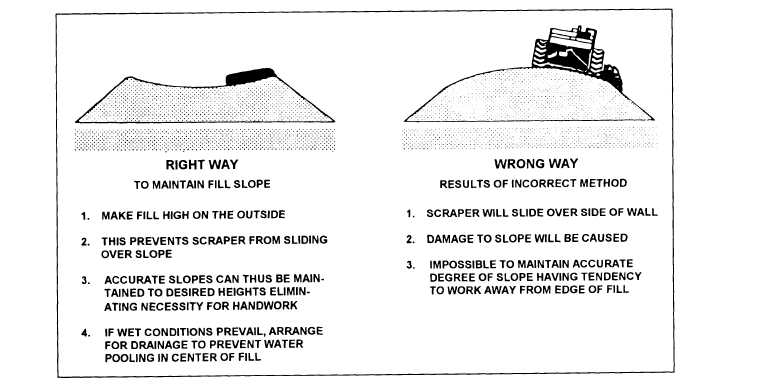fill. When traveling too close to the next scraper, spread
the load at the far end of the fall.
NOTE: Keep the scraper bowl as close to the
ground as possible to lower its center of gravity and to
keep it upright.
Spreading
Techniques for scraper spreading operations are as
follows:
l Spread the first load at the start of the fill.
l Travel with subsequent loads over the previous
fill, provided lifts are small.
. Make each following spread start at the end of
the previous layer.
. Finish spreading in one full length before starting
a new lane, so rollers can begin compaction.
. Route the scrapers to compact the fill. Over-
lapping the scraper tire tracks aids in the compaction of
the entire area and reduces the compaction time
necessary with a roller.
l Spread in the highest gear permitted by the
condition of the fill area terrain.
NOTE: Slowly discharging loads at low speed
slows down production and cycle time.
l Do not waste time on the fill. As soon as the load
is spread, get the scraper back on the haul road and return
to the cut. Plan your exit from the fill to avoid soft
ground and detours around trees and other obstacles.
. As shown in figure 10-49, make the fill high on
the outside edge. This prevents the scraper from sliding
over the outside edge and helps in maintaining accurate
slopes to desired heights. When the fill is not made in
this manner, the scraper tends to work away from the
edge of the fill, making it hard to maintain the correct
slope. In inclement weather, build the low center up for
drainage.
SCRAPER SAFETY
Safety precautions that apply to scrapers are as
follows:
. Never operate a scraper at speeds that are unsafe.
. Always wear seat belts. Uneven terrain can
cause a violent tilt of the scraper, causing possible
personal injury by throwing you off or against the
steering wheel if NOT secured in the operator’s seat.
Figure 10-49.-Proper placement of fill material.
10-27

